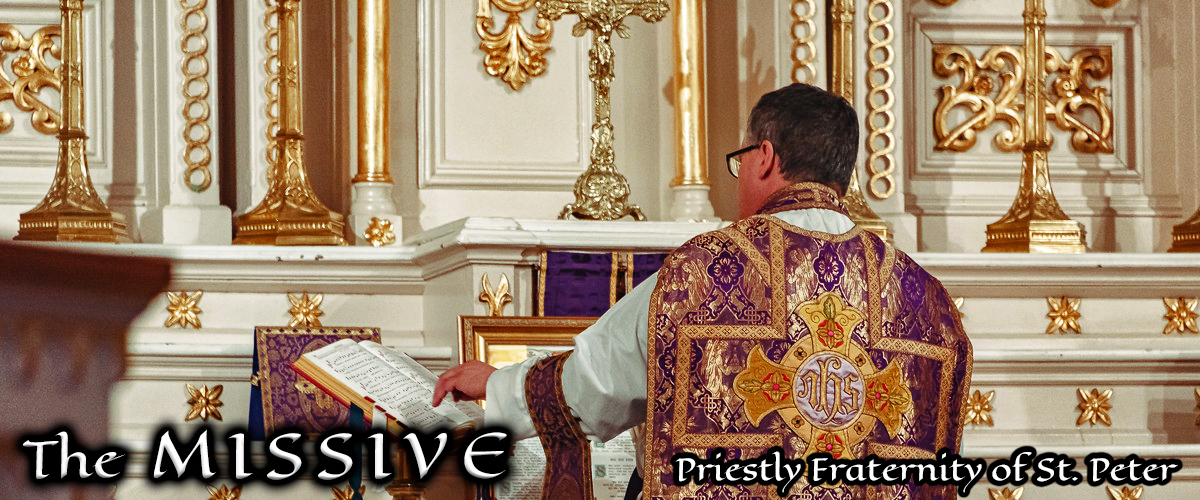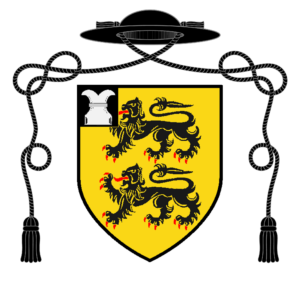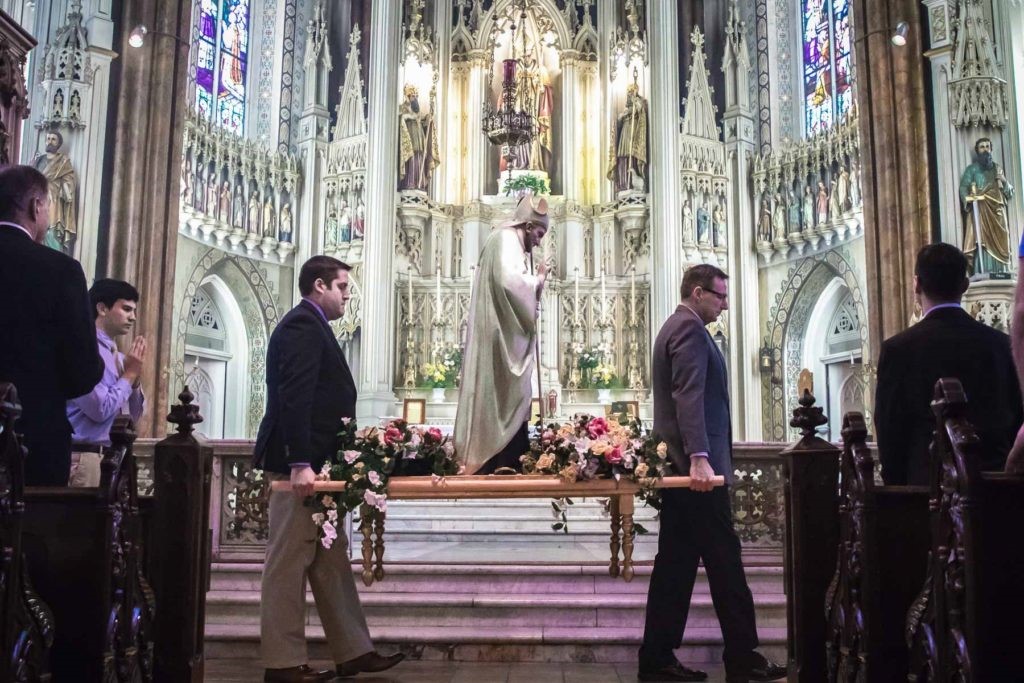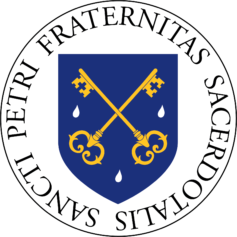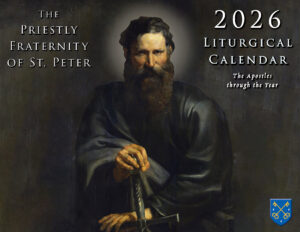St. Peter and the Sea
by Rev. Cav. William Rock, FSSP, SMOCSG

In the fourteenth chapter of the Gospel of Matthew is found the account of St. Peter’s sinking into the sea after walking upon it and his subsequent rescue by Our Lord (14:28-33). Perhaps unsurprisingly, this incident has found its way into the liturgy of the Roman Church which was founded by this same Apostle.
The first time one is most likely to encounter this episode is when it is referenced among the ceremonies of the very Sacrament which makes one a member of Church, that of Baptism. In the first exorcism of the Baptismal ceremony in both the Roman Ritual and the Roman Pontifical, the “accursed and damned one” is commanded by “He Who walked upon the sea and stretched out His hand to the sinking Peter.”1 This is a very fitting reference as immersion, the full submersion of the one being baptized under the water, was the common practice in the early Church.2 It is easy to see symbolized by Peter and Christ the one submerged and the one raising him out of the waters. For just as Christ lifted Peter out of the water thus saving him from death, so does the priest raise the one submerged out of the font saving him from the death of sin and bringing him to a new, supernatural life.
There are two other references to this event in the Roman Ritual, namely in the blessing of a boat (navis)3 and in the solemn blessing of, specifically, a fishing-boat (benedicito solemnis navis piscatoriæ)4 (this second blessing was approved by the Congregation of Sacred Rites on April 10, 1912). In both, it is prayed: “Reach out Thy hand to them [the passengers], Lord, as Thou did to blessed Peter as he walked upon the sea.” This is, of course, a prayer for the safety and protection of those on the boat, that they be guarded against the dangers of the waves and winds which can be encountered while out on the water. The full text of the prayer in which this petition is found is common to both blessings and reads as follows:
Lord, be well disposed to our prayers, and by Thy holy hand bless + this ship [or fishing-boat] and its passengers, as Thou were pleased to let Thy blessing hover over Noe’s ark in the Deluge. Reach out Thy hand to them, Lord, as Thou did to blessed Peter as he walked upon the sea. Send Thine holy angel from on high to watch over it and all on board, to ward off any threat of disaster, and to guide its course through calm waters to the desired port. Then after a time, when they have successfully transacted their business, may Thou in Thy loving providence bring them back with glad hearts to their own country and home. We ask this of Thee who live and reign forever and ever.5
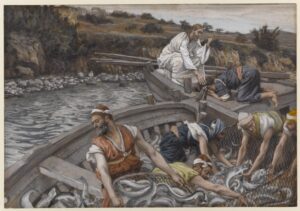
It is interesting that this prayer attributes to God the Son Himself the blessing given to Noe’s ark during the Flood, a reminder that all Three Persons of the Trinity acted together throughout the events recorded in the Old Testament. The request for the Holy Angel mirrors that found in the blessing of a house and in the prayer which accompanies the Asperges at Holy Mass. For those who may be interested, the blessing of a fishing-boat runs several pages and involves the dedication of the boat to a particular titular saint. It is likely that this blessing is meant for a commercial fishing-boat, not a recreational one.
Turning to the Missal, this episode is read as the Gospel (Matt 14:22-33) on the Octave Day of Sts. Peter and Paul (July 6th).6 The collect for this Mass also references this event:
O God, Whose right hand upheld blessed Peter walking upon the waves lest he should sink, and delivered his fellow-apostle Paul when shipwrecked for the third time from the depth of the sea; hear us in Thy mercy, and grant that through their merits we may obtain the glory of everlasting life: Thou Who livest…7
This same oration is found in the Votive Mass of Sts. Peter and Paul recommended for Wednesdays later in the Missal. In this votive Mass, however, the oration is not in harmony with the Gospel reading, which is the same as that read during the Octave (Matt 19:27-29) rather than that of the Octave Day itself. As per usual, the Gospel and oration of the Octave Day are also utilized in the Office of the day.
Lastly, turning to the Breviary, in addition to what has already just been noted, the second antiphon for Vespers and Lauds for the Feasts of the Finding (May 3rd)8 and Exaltation (September 14th) of the Holy Cross unites Our Lord’s saving of St. Peter with the saving power of the Cross:
Save us, O Christ the Saviour, through the might of Thy Cross: Thou Who didst save Peter on the sea, have mercy on us.
A common theme throughout is that this incident is invoked as an expression of God’s power and ability to save from both natural and spiritual peril and confidence that, in accordance with His wisdom, He will so do in favor of his faithful. May the faithful then, when inundated by the winds and waves of this world, imitate St. Peter and cry out for God’s help confident that He will not let a soul which trusts in Him be lost.
Rev. Cav. William Rock, FSSP, SMOCSG was ordained in the fall of 2019 and was invested as an Ecclesiastical Knight of the Sacred Military Constantinian Order of St. George in the summer of 2025. He currently resides at the FSSP Canonical House of St. Casimir in Nashua, NH, and ministers at St. Stanislaus parish.
In support of the causes of Blessed Maria Cristina, Queen, and Servant of God Francesco II, King
- Rituale Romanum [1957], Titulus II. Translation adopted from: Manus, Frederick. Parish Ritual. (New York: Benziger Brothers, Inc., 1962), p. 5.
- The old Catholic Encyclopedia, s.v. “Baptism.”
- Rituale Romanum [1957], Titulus IX – Caput 8.5.
- Rituale Romanum [1957], Titulus IX – Caput 8.6.
- Translation adapted from the Weller translation provided online by EWTN (2, VIII, 19 and 20).
- This octave was removed from general observance by Pope Pius XII in 1955 with the decree Cum hac nostra aetate. Perhaps the day will come when this octave is restored, fittingly, for the use of the Priestly Fraternity of St. Peter.
- Translation adopted from the Saint Andrew Daily Missal (St. Paul: The E. M. Lohmann Co., 1940), p. 787. Original Latin: Deus, cujus déxtera beátum Petrum, ambulántem in flúctibus, ne mergerétur, eréxit, et coapóstolum ejus Paulum, tértio naufragántem, de profúndo pélagi liberávit: exáudi nos propítius, et concéde; ut, ambórum méritis, æternitátis glóriam consequámur: Qui vivis.
- This feast was also removed from general observance by Pope John XXIII, but its Mass can still be celebrated on May 3rd as a votive.
October 6, 2025
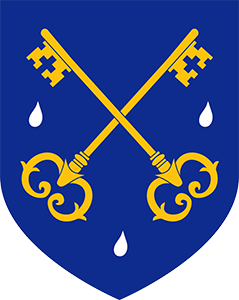
The Sixteenth and Seventeenth Sundays after Pentecost (Hebrew Lunar Calendar)
by Fr. Mark Wojdelski, FSSP
(This is part of a series of articles. The first and foundational article can be found here.)
Now that you have had a chance to let these ideas settle in your mind, let us revisit the “month” that we find ourselves in now, the fictitiously liturgical (or liturgically fictitious), and yet entirely real month of Tishri, which includes the sixteenth through twentieth Sundays after Pentecost. Remember, we are simply counting forwards from Easter, 17 Nisan; seven Sundays from Easter to Pentecost, and sixteen more take us to the month of Tishri, which in this arrangement providentially begins on Sunday, the first day of the week. If you read my first article, you are now able to figure these things out on your own with a pencil and paper or an old calendar. If you have not read the first article, it is available here. So here we are at the sixteenth Sunday after Pentecost, the beginning of the month of Tishri, from the point of view of our liturgical year.
This is an interesting month for several reasons. The first day of this month is also the first day of the civil year, and so the normal Rosh Hodesh (new moon) is a special one.
“And the Lord said to Moses, Say to the sons of Israel, In the seventh month, on the first day of the month, you shall observe a day of solemn rest, a memorial proclaimed with blast of trumpets, a holy convocation. You shall do no laborious work; and you shall present an offering by fire to the Lord.” (Lev 23:23-25)
The collect for the Mass for the sixteenth Sunday after Pentecost likewise seems to contain an allusion to a transition from one year to the next: “May Thy grace, we beseech Thee, O Lord, ever go before us and follow after us; and make us always intent upon good works. Through our Lord Jesus Christ, Thy Son, etc.”
This particular choice of words, and the notion of God’s grace “going before and following” (Tua nos quaesumus Domine gratia et praeveniat et sequatur) is interesting. The new year on the Roman solar calendar begins in January. It was not always so, but the shift of the new year from March to January was understandable, given that the month of January is named after Janus, the Roman god typically depicted with two faces facing in opposite directions, and to whom was attributed patronage of change and transition. One face looks forward to the future, while the other looks backward and contemplates what has already taken place. St. Augustine makes this observation in his discussion of the Roman gods Janus and Terminus (“End”): “Would it not be a far more elegant interpretation of his two faces to say that Janus and Terminus are actually the same, and to assign one face to beginnings and the other to endings?”1
Every new year is both a beginning and an end. We put the old year behind us and the new year before us, and ask that the grace of God be behind us and in front of us. This also serves as a reminder to us that our prayer stretches behind us and ahead of us. Why would we pray that the grace of God go behind us? Why do our funeral liturgies ask that the soul of the departed be spared the pains of hell? If the person is already dead and judged, what difference would that make? We tend to imagine past events as unaffected by our prayers, but God is outside time. Who can say that our prayers now might not mitigate the effects of some terrible past event? We certainly know that what is past cannot be undone, but how can we perceive the intentions of Him who is the creator of time?
Continuing along, we come to the next occurrence on the Hebrew calendar, 3 Tishri, known as “Tzom Gedaliah” or the Fast of Gedaliah. This commemorates the following event relating to the Babylonian captivity:

“And over the people who remained in the land of Judah, whom Nebuchadnezzar king of Babylon had left, he appointed Gedaliah the son of Ahikam, son of Shaphan, governor. Now when all the captains of the forces in the open country and their men heard that the king of Babylon had appointed Gedaliah governor, they came with their men to Gedaliah at Mizpah, namely, Ishmael the son of Nethaniah, and Johanan the son of Kareah, and Seraiah the son of Tanhumeth the Netophathite, and Jaazaniah the son of the Maacathite. And Gedaliah swore to them and their men, saying, ‘Do not be afraid because of the Chaldean officials; dwell in the land, and serve the king of Babylon, and it shall be well with you.’ But in the seventh month, Ishmael the son of Nethaniah, son of Elishama, of the royal family, came with ten men, and attacked and killed Gedaliah and the Jews and the Chaldeans who were with him at Mizpah. Then all the people, both small and great, and the captains of the forces arose, and went to Egypt; for they were afraid of the Chaldeans.” (2 Kgs 25:22–26)
The fast on this day is certainly that one mentioned in Zechariah: “Thus says the Lord of hosts: The fast of the fourth month, and the fast of the fifth, and the fast of the seventh, and the fast of the tenth, shall be to the house of Judah seasons of joy and gladness, and cheerful feasts; therefore love truth and peace.” (Zec 8:19) The prophet had made a previous mention of the fast of the fifth and the seventh month, both relating to the Babylonian exile. (Zec 7:5) These four fasts do NOT include the Day of Atonement, as that is a very unique day. Rather, these “four fasts” all pertain to events surrounding the Babylonian captivity: the one we just mentioned, the commemoration of the beginning of the siege of Jerusalem by the Babylonians (10 Tevet, 2 Kgs 25:1 and Ezek 24:1-2) and the two days commemorating the ending of the daily sacrifice and the destruction of the temple (17 Tammuz, Jer 39:2, and 9 Av, 2 Kgs 25:8-9).
An important point that needs to be made at this time is that any Jewish observance from before the coming of Christ, even if it is not explicitly in the scriptures, but is only known from later pre-Christian tradition, ought to be considered authentic, and part of our shared common tradition, because until they inexplicably and mysteriously rejected their Messiah, the Jews had the faith, the exact same grace of faith that we have. Otherwise, those righteous Jews who died before the coming of Christ could not have been saved. “By faith Enoch was taken up so that he should not see death; and he was not found, because God had taken him. Now before he was taken he was attested as having pleased God. And without faith it is impossible to please him. For whoever would draw near to God must believe that he exists and that he rewards those who seek him.” (Heb 11:5–6) So, although the date of 3 Tishri for this observance is not explicitly found in the scriptures, it can be regarded with as much authority as the observed date of December 25 for the birthday of our Savior, as this date was observed long before the first Christmas. However, none of these dates have any significance for the Christian without a connection to the celebration of Easter.
A lesson to be learned from this fast for the assassination of Gedaliah is that the secular authority is also imposed upon us by almighty God as a chastisement or punishment, but that does not excuse us from our obligations to it. Having to fill out your taxes every year is in itself a little chastisement from God for your own sanctification. What other reason could there be for having a special penitential fast because a politician was assassinated? After all, in the end, that is all that Gedaliah was. Yes, he was regarded as a righteous man by the Jews, and he was no doubt an admirable man on the carnal level, but he likely got his position through some connections he had made with the invading Babylonian officials, and was able to get himself installed as governor of the land of Judah. Most of the remaining Jews probably made the mistake we too make, which the Psalmist reminds us not to make: “It is good to confide in the Lord, rather than to have confidence in man.
It is good to trust in the Lord, rather than to trust in princes.” (Ps 117:8–9)
Have politics changed so much since biblical times? We were given this short summary of the historical events in the book of Kings, but perhaps that’s all we need. The inspired writer knew that people even thousands of years later would understand how politics work, and they would also understand how easily a bunch of rebels could band together and take out their enemy, whether perceived or real, but that is not, in fact, what God wants.
Life, death, and judgment belong to the Lord, and the final judgment of our leaders is also placed in His hands. It is not ours to dispense, as St. Peter said: “Be subject for the Lord’s sake to every human institution, whether it be to the emperor as supreme, or to governors as sent by him to punish those who do wrong and to praise those who do right. For it is God’s will that by doing right you should put to silence the ignorance of foolish men. Live as free men, yet without using your freedom as a pretext for evil; but live as servants of God. Honor all men. Love the brotherhood. Fear God. Honor the emperor.” (1 Pet 2:13–17)
The next “official” occurrence on our calendar is the seventeenth Sunday after Pentecost, corresponding to 8 Tishri. The collect seems to point towards the coming Day of Atonement: “Grant, we beseech Thee, O Lord, to Thy people, to avoid all contact with the devil: and with pure minds to follow Thee, the only God.”
The gospel reading also suggests coming humiliation and penance: “Because every one that exalteth himself shall be humbled: and he that humbleth himself shall be exalted.” (Lk 14:11)
If we imagine that the week in which the Ember days fall is always after the 17th Sunday after Pentecost, as that is where the Ember Days fall in the missal (see previous article for this), we “should” be reading the book of Tobit this week at matins to correspond with the Ember Days in the third week of September, and in our idealized year, today we would read the introduction:
I, Tobit, walked in the ways of truth and righteousness all the days of my life, and I performed many acts of charity to my brethren and countrymen who went with me into the land of the Assyrians, to Nineveh. Now when I was in my own country, in the land of Israel, while I was still a young man, the whole tribe of Naphtali my forefather deserted the house of Jerusalem. This was the place which had been chosen from among all the tribes of Israel, where all the tribes should sacrifice and where the temple of the dwelling of the Most High was consecrated and established for all generations for ever.
All the tribes that joined in apostasy used to sacrifice to the calf Baal, and so did the house of Naphtali my forefather. But I alone went often to Jerusalem for the feasts, as it is ordained for all Israel by an everlasting decree. Taking the first fruits and the tithes of my produce and the first shearings, I would give these to the priests, the sons of Aaron, at the altar. Of all my produce I would give a tenth to the sons of Levi who ministered at Jerusalem; a second tenth I would sell, and I would go and spend the proceeds each year at Jerusalem; the third tenth I would give to those to whom it was my duty, as Deborah my father’s mother had commanded me, for I was left an orphan by my father. (Tob 1:3-8)
And, as Fr. Rock has already observed here, the homily for this day is one of St. Leo’s on “the fast of the seventh month.”
Typically, at this time of year, the matins readings do not have a tight correspondence to the sequence of Sundays, but this one time, due to it being the week containing the Ember Days, we can make an exception to this rule, and imagine that this is the proper “home” of this book of the bible in the cycle of readings because of its close connection to the Ember days. You’ve had to use your imagination quite a bit leading up to this point already, so please continue to bear with me.
On this day, Solomon began the dedication of the first temple, 7 days and 7 more days, ending with 22 Tishri, the eighth day of the feast of Tabernacles, the day of “solemn assembly,” after which we are told that he sent the people home. (2 Chr 7)
Next we have the Day of Atonement. (10 Tishri) This comes right before the Fall Ember days, which eventually took the place of all the fall penitential observances for the Roman Christians.
Recall what Moses told the people:
“On the tenth day of this seventh month is the day of atonement; it shall be for you a time of holy convocation, and you shall afflict yourselves and present an offering by fire to the Lord. And you shall do no work on this same day; for it is a day of atonement, to make atonement for you before the Lord your God.” (Lev 23:26-27) The term “afflict yourselves” refers to being humbled or bowed over, but it additionally includes the notion of fasting.2 The Jewish calendar does not have many fast days prescribed, but this is an unusual fast, as work is also forbidden. Ordinarily days on which work was forbidden were joyful holidays, including the first and seventh day of the feast of Unleavened Bread, Pentecost, and the feast of Tabernacles on the first and eighth day. But on this day, men are not allowed to eat and may not even do anything to better their miserable condition through work. They must acknowledge their own helplessness in the sight of God. We Catholics have many opportunities to humble ourselves in our hearts, by the grace of God, and that more than once a year. The Israelites simply had to do it with their bodies, once a year.
The Ember Days and the rest of the month will be discussed in the next article.
1Saint Augustine, The City of God, ed. Boniface Ramsey, trans. William Babcock, vol. 6, The Works of Saint Augustine: A Translation for the 21st Century (Hyde Park, NY: New City Press, 2012–2013), 214.
2 וְעִנִּיתֶ֖ם אֶת־נַפְשֹׁתֵיכֶ֑ם literally “humble your souls” — Francis Brown, Samuel Rolles Driver, and Charles Augustus Briggs, Enhanced Brown-Driver-Briggs Hebrew and English Lexicon (Oxford: Clarendon Press, 1977), 776.
September 27, 2025

The Fast of the Seventh Month
by Rev. Cav. William Rock, FSSP, SMOCSG
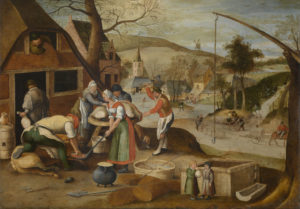
One of the most ancient practices of Christianity as practiced in the city of Rome is the keeping of the Ember Days (Latin Quatuor Tempora, “four times”). According to the old Catholic Encyclopedia, “the ‘Liber Pontificalis’ ascribes to Pope Callistus (217-222) a law ordering the fast, but probably it is older. Pope St. Leo the Great (440-461) considers it an Apostolic institution.”1
For those who may be unfamiliar, the Ember Days are four sets of three days (Wednesday, Friday, and Saturday) somewhat evenly spaced throughout the year which are kept as days of penance. In the 1917 Code of Canon Law, the Ember Days were to be kept as days of fasting and abstinence, with no exception for those which corresponded with the Octave of Pentecost (the Ember Days, it should be noted, predate this Octave) (canon 1252.2). By 1962, the abstinence on Ember Wednesdays and Saturdays was reduced to partial. These sets of days, as they correspond, some better than others, with the changes of natural seasons, were observed as a way to give thanks to God for the blessings of the previous season and to ask His blessing on the one beginning. As ordinations at Rome historically occurred on Ember Saturdays, these days were also days of preparation for this event.
With respect to their origin, the Ember Days seem to be a christianization of Roman agricultural celebrations with the December Ember Days being the christianization of the feriæ sementivæ (“for the seeding”), the Summer Ember Days of the feriæ messis (“for a bountiful harvest”), and the Autumn Ember Days of the feriæ vindimiales (“for a rich vintage”).2 The Lenten, or Spring, Ember Days, which seem to be without an agricultural precedent, were added, presumably, to balance out the year. The Autumn and Winter Ember Days are also called the Fast of the Seventh Month and Fast of the Tenth Month, respectively. Lest there be any confusion regarding calling the September Ember Days the Fast of the Seventh, and not the Ninth, Month and the December Ember Days the Fast of the Tenth, and not the Twelfth, Month, it is important to note that the Roman calendar, prior to the reform under Julius Caesar (d. 44 B.C.), originally marked the beginning of the year in the spring with March being the first month,3 thus making September the seventh and December the tenth, hence their names (septem, “seven”; decem, “ten”).4 So while September and December were not the seventh and tenth calendar months at the dawn of Roman Christianity, they were still the seventh and tenth months by name.
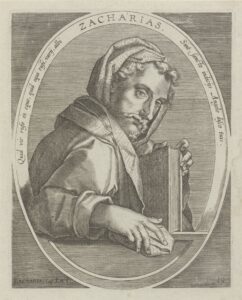
Some authors, such as Servant of God Dom Prosper Guéranger,5 attempt to justify the keeping of the Ember Day fasts by invoking the Prophet Zacharias (8:19): “Thus saith the Lord of hosts: The fast of the fourth month, and the fast of the fifth, and the fast of the seventh, and the fast of the tenth shall be to the house of Juda, joy, and gladness, and great solemnities: only love ye truth and peace.” The Fasts of the Seventh Month and of the Tenth Month mentioned by the Prophet, then, would correspond with the September and December Ember Days. The Fast of the Fourth Month would correspond with the Ember Days following the Feast of Pentecost which can fall between May (the third month) 10 and June (the fourth month) 13. If one were to assign a correspondence in the Roman liturgical calendar for the Fast of the Fifth Month, the fasts before the Feast of the Nativity of St. John the Baptist and before the Feast of Sts. Peter and Paul, both celebrated in late June, close to July, the original fifth Roman month, serve as possible candidates. It is not by coincidence, then, such authors would argue, that this passage of the Prophet is read as part of the Fourth Lesson on September’s Ember Saturday (Zach 8:14-19). Rather, it is the Church’s liturgy itself giving witness to the origin of these fasts.
It is clear, however, that there is not a perfect correspondence between the passage from Zacharias and the Roman liturgical calendar. This is most likely due to the Prophet being invoked as a justification for a practice which was already being kept rather than the passage serving as the inspiration of the practice. As was said above, the origin of the Ember Days is more likely a christianization of Roman agricultural celebrations at a very early date rather than the application of the writings of an Old Testament Prophet to the Christian liturgical year, although the Scripture text may have inspired the names of these christianized observances. Dom Guéranger himself notes that “in the early writers” there is mention “of the three times [of fasting] and not the four,”6 but argues this is because the Ember Days of Lent add nothing to the Lenten fast already being observed. Again, it seems more likely that the Spring Ember Days were added later, but by the time of Pope Gelasius (A.D. 492-496), to balance out the calendar.

Starting in August and continuing until the start of Advent, the weekly Sunday and ferial Scriptural Lessons as well as any Patristic Commentaries for the Office of Matins, the Church’s night office, are determined by the week of the month and not by weeks after Pentecost as are the Sunday Gospel lections, their commentaries, and orations. Prior to this, however, even the weekly Sunday and ferial Scriptural Lessons as well as any Patristic Commentaries are also determined by the weeks after Pentecost. In the Breviary, the material for the September Ember Days is presented on the Wednesday, Friday, and Saturday of the Third Week of September as these Ember Days always fall during this third week. On each of these days, a short commentary from a Father of the Church on the Gospel of the day is given. However, at the start of the week, that is, for the Third Sunday of September, prior to the changes made to the Breviary under Pope John XXIII (d. A.D. 1963),7 in place of a commentary on the preceding Scriptural Lessons as is usual, the readings for the second nocturn are taken from Pope St. Leo the Great’s Ninth Sermon on the Fast of the Seventh Month. In this Sermon, the Holy Pontiff touches on keeping the expected fast and the spiritual advantages of giving alms. This all resonates well with the reasons expressed by the old Catholic Encyclopedia for the institution of the Ember Days: “The purpose of their introduction, besides the general one intended by all prayer and fasting, was to thank God for the gifts of nature, to teach men to make use of them in moderation, and to assist the needy.”8 At the conclusion, the Holy Pontiff mentions the station at St. Peter’s, which is still listed as the station in the Missale Romanum, the station being the church in Rome where the Pope himself would say Mass on certain days.
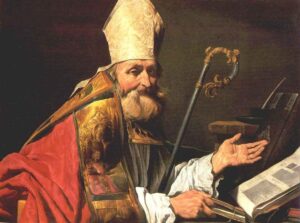
On the Sunday following, the Fourth Sunday of September, the Patristic Commentary for the second nocturn is taken from St. Ambrose’s Book upon Elijah and Fasting. The text chosen is not a strict commentary on the preceding Scriptural Lessons, which are taken from the Book of Judith, but she is referenced. There is also a connection with the Sunday next, on which the Book of Esther is begun, by the mention of her. In the text provided, Ambrose, Bishop of Milan (d. A.D. 397), first details the dangers of drink and drunkenness while extolling sobriety. This is a fitting warning to be read following the September Ember Days which are associated, it is believed, with the Roman vintage festival. The Saint also praises the fruits of fasting by extolling the deeds wrought by God through these two great women which He granted them in light of their fasts, Esther’s even being kept for three days. As the Church has just finished three days of fasting herself, such a reminder of the benefits of fasting is timely.
For the sake of the edification of the faithful as we enter into these Autumn Ember Days and so that they may keep these days with the same spirit which was expected of the early Christians and which the Church perennially expected of her children by including them in her liturgy, I here present translations of these readings just mentioned.9
For the Third Sunday of September from Leo’s Ninth Sermon on the Fast of the Seventh Month:
Well do I know, dearly beloved, that many of you are fervent in your observance of all those practices which belong to the Christian Faith, so that ye have no need to be admonished by our exhortations. For what tradition hath laid down, and custom well established, is neither unknown to the learned nor neglected by the devout. But because it appertaineth to the priestly office to exercise the same general care over all the Church’s children in all such matters as be profitable alike to the learned and to the simple (both of whom are equally dear to us), we do now exhort the both of you to celebrate, with lively faith, and all due discipline of soul and body, the Quarterly Fast, which the seventh month [that is, September] doth once again bring to us in its yearly round.
The Ember Days of fasting are appointed to the four seasons [observántia quátuor est assignáta tempóribus], in order that their quarterly recurrence in the course of the year may teach us how unceasingly we need to be purified, and how, as long as we are tossed about by the changes and chances of this life, we need through fasting and alms-deeds to be cleansed from the stain of that sin which we have contracted by the frailty of our flesh and our concupiscence. Let us diminish a little, beloved, what we are accustomed to use for ourselves, in order that we have somewhat more to use for the relief of the poor and needy.
The conscience of the generous can thus be made glad by the fruits of their own liberality. Whilst thou art giving happiness thou shalt receive joy. Thy love for thy neighbor is a unity with thy love for God; and He hath taught us that in the unity of this twofold charity is to be found the fulfillment of all the Law and the Prophets. Further, if anyone doubt that what is given to man is offered to God, we have the saying of our Lord and Saviour, when He spake of feeding and helping the poor: Inasmuch as ye have done it unto one of the least of these, My brethren, ye have done it unto Me. Wherefore, let us fast on Ember Wednesday and Friday; and on Ember Saturday let us also keep vigil at the shrine of blessed Peter the Apostle; by whose merits and prayers we believe that we shall be aided, so that we may please our merciful God in our fasting and prayer.
For the Fourth Sunday of September from Ambrose’s Book upon Elijah and Fasting (Ch. 9):
It is not for kings to drink wine, nor for princes strong drink, lest they drink and forget the law. Prov. xxxi. 5. The rulers drank wine even unto drunkenness, who planned to deliver themselves into the hand of Holofernes, captain of the host of the King of the Assyrians but the woman Judith drank not, who fasted all the days of her widowhood, saving the solemn Feast-days. She went forth in the harness of this abstinence, and over-reached the whole army of the Assyrians. By the clear thought of her soberness she took away the head of Holofernes, kept her chastity, and carried off the victory.
Armed with fasting, she entered the camp of the strangers. He lay soaked in wine, so that he could not feel the blow that slew him. And thus, the fast of one woman overthrew the countless armies of the Assyrians. Esther also became fairer by fasting for the Lord gave favour unto her for her soberness. She delivered all her nation, that is, the whole people of the Jews, from the fierceness of persecution, so that she brought down the king himself under her will.
Thus also [Esther] who fasted three days, and washed her body with water, found greater favour, and obtained vengeance, whereas Haman, who boasted himself at the king’s table, paid the penalty of his drunkenness, even while yet he was in his cups. Fasting, therefore, is a sacrifice of reconciliation, a means of strength, whereby in the might of grace, women wax manful. Fasting knoweth not usury, nor the gain of the usurer the faster’s table smelleth not of usury, but the fast itself giveth favour to them that sit at meat. A banquet is all the pleasanter after hunger, whereas by constant use it becometh unattractive, and when it is long carried on cometh to be lightly esteemed. Fasting is a good sauce for meat. The keener the appetite, the more toothsome the food.
Rev. Cav. William Rock, FSSP, SMOCSG was ordained in the fall of 2019 and was invested as an Ecclesiastical Knight of the Sacred Military Constantinian Order of St. George in the summer of 2025. He currently resides at the FSSP Canonical House of St. Casimir in Nashua, NH, and ministers at St. Stanislaus parish.
In support of the causes of Blessed Maria Cristina, Queen, and Servant of God Francesco II, King
- The old Catholic Encyclopedia, s.v. “Ember Days.”
- Ibid.
- Ibid., s.v. “New Year’s Day.”
- Whitaker’s Words, s.vv. “Septem” and “Decem.”
- Guéranger, Prosper. The Liturgical Year, vol. 1 (Advent). Trans. Shepherd, Laurence. (Fitzwilliam: Loreto
Publications, 2000), pp. 218-221. - Ibid., p. 219.
- In the changes made by Pope John XXIII in 1960, Sunday Matins was reduced to one nocturn and the readings of the second nocturns omitted. With respect to the matter at hand, it seems to be a great loss that the Autumn Ember Day sermon of Leo, which testifies to the antiquity of the Ember Days, is no longer part of the Church’s official liturgy.
- The old Catholic Encyclopedia, s.v. “Ember Days.”
- The translations are taken from the Divinum Officium Project with modifications in some places.
September 24, 2025

The Hebrew Calendar and the Traditional Roman Liturgy
by Fr. Mark Wojdelski, FSSP
I am planning, God willing, to do a series of articles on how the traditional Roman Liturgy aligns with the cycle of Jewish feasts. Having done extensive research, but not knowing where to begin, I informally consulted with some of my brother priests at our last general meeting. One of them said, “What’s a lunar calendar?” So I think that is a good place to start. At the end of this series of articles, it is hoped that people will see what a work of art the ancient Roman liturgy is, not only the Mass, but even the Divine Office. We will also see the continuity between the practice of religion before Christ and after His coming in the flesh. It is like a beautiful symphony that changes keys, but maintains the same harmony. Miracles have been described in this way, as God modulating the cosmic music, rather than violently manipulating His creation. We often speak of the New Testament being hidden within the Old. It appears that the liturgy of the old Covenant is also hidden within the new.
Every Catholic is well aware of the fact that the date of Easter moves around the calendar every year. Not every Catholic knows why. When I was a little boy in Catholic school, Fr. Mike Foley, then a young priest of the Archdiocese of Chicago, taught us the answer to this (perhaps in the fifth or sixth grade), by asking us a question, and promising that if any student knew the answer, that he or she would be exempt from religion class until graduation. Of course, none of us knew the correct answer: that Easter Sunday is always the Sunday after the first full moon after the beginning of spring (formally known as the vernal equinox, but we were only kids, so he spared us the additional astronomy lesson). The Church defines the equinox as March 21 for purposes of unity and consistency, even though the actual equinox can move a bit. So to simplify, we can simply say that the Church has decided that Easter is the Sunday after the first full moon after March 21.
The reason for this is that the crucifixion of our Lord occurred during the feast of the Unleavened Bread, which was observed for seven days after Passover. The feasts of the Jewish religion are all defined by lunar occurrences, specifically counting days after the new moon (when the first sliver of the crescent moon is just visible after the sun sets). The full moon will occur about 14 days after that new moon sighting, and it did need to be seen by human eyes, so the lunar calendar in antiquity was called “observational.” The location that eventually became the standard place of observation for the Jews was naturally Jerusalem. Two witnesses had to come forward to the priests, who would then question them on what precisely they saw (where, how high in the sky, how the moon was oriented) and if their answers were satisfactory, the new moon was declared and the trumpet blown, signifying that the month had begun. The beginning of the month was called “Rosh Hodesh” (the “head of the month”) as we analogously say “Rosh Hashanah” for the Jewish new year. Technically, “hodesh” simply means “newness” in Hebrew.
In fact, in the early church, there was a controversy surrounding the date of Easter, with some insisting that Easter be always celebrated on the fourteenth day of the first month (called Nisan), no matter what day of the week it happened to be, and others saying that it should always be celebrated on a Sunday, the first day of the week, as this was the day our Lord rose from the dead. There are mystical and theological reasons for both positions, but ultimately the second opinion prevailed, and we now celebrate Easter as we do. The discrepancy between the Western celebration of Easter and the Orthodox Easter has nothing to do with the moon, but rather has to do with the fact that the Orthodox continue to use the Julian calendar, which has a drift of three solar days every 400 years, an error that was corrected—quite well, incidentally—by the reform of the calendar under Pope Gregory XIII in 1582. For this reason, the date of Easter on the Orthodox calendar will continue to fall later and later as centuries go by.
* * *
The Hebrew lunar calendar has twelve months, each month having either 29 or 30 days. It takes the moon about 27.3 days to revolve around the earth, but the earth meanwhile is moving around the sun at the same time, and so the observed lunar cycle turns out to be about 29.5 days. The months are as follows:
|
Month |
Name |
Season |
Modern Equivalent |
|
1 |
Nisan (or Abib) |
Spring |
March-April |
|
2 |
Iyar (Ziv) |
Spring |
April-May |
|
3 |
Sivan |
Spring |
May-June |
|
4 |
Tammuz |
Summer |
June-July |
|
5 |
Av |
Summer |
July-August |
|
6 |
Elul |
Summer |
August-September |
|
7 |
Tishri (Ethanim) |
Fall |
September-October |
|
8 |
Heshevan (Bul) |
Fall |
October-November |
|
9 |
Kislev |
Fall |
November-December |
|
10 |
Tevet |
Winter |
December-January |
|
11 |
Shevat |
Winter |
January-February |
|
12 |
Adar |
Winter |
February-March |
The names of the months are taken from the Babylonians, whose astronomers perfected the lunar calendar and the cycles of lunations. The names given in parentheses are the older Canaanite names, which appear in the Old Testament occasionally. This gives us a total of 354 days, assuming an even pattern of alternating 29- and 30-day months. However, because the solar year is 365 days, we are presented with a problem, since after a few years the first month of spring would be so early that there would be no grain to harvest yet, and since Passover and the feast of Unleavened Bread were tied to the growing season, something would have to be done. In order to correct the error in the drifting apart of the cycles of the sun and the moon, the priests would declare a “leap month” after Adar, which they simply called Adar II or Va’Adar (literally “And Adar”). This would then realign the cycle of the sun and moon enough so as not to disrupt society. Later, after the Sanhedrin was disbanded in the fourth century, the rabbis adopted what is called the Metonic cycle, known to the Greeks as well as the Babylonians, by which direct observation of the moon was no longer necessary. A 19-year cycle is used, with a regular pattern of leap months and two months whose length can vary from 29 to 30 days from year to year depending on what is needed to keep everything aligned. This system remains in use to this day.
Before turning to the Christian feasts, a brief general overview of the Hebrew feasts will be helpful. There are other observances which we will look at later as they come up, but the major holidays are enumerated in the book of Leviticus, chapter 23 (RSV2 Catholic Edition):
“The Lord said to Moses, Say to the sons of Israel, The appointed feasts of the Lord which you shall proclaim as holy convocations, my appointed feasts, are these. Six days shall work be done; but on the seventh day is a sabbath of solemn rest, a holy convocation; you shall do no work; it is a sabbath to the Lord in all your dwellings.” (Lev 23:1-3)
This observance is so frequent that it is often forgotten, in the same way that we don’t think much of Sunday when it rolls around every week—unless, of course, you are a priest, then your whole life revolves around it. We will see the phrase “holy convocation” (miqra’ qodesh) come up repeatedly. The term is aptly rendered, as it is literally a “calling of holiness.” The original Christian feast was simply the observance of the new weekly day of rest, Sunday, the day of the Resurrection.
“These are the appointed feasts of the Lord, the holy convocations, which you shall proclaim at the time appointed for them. In the first month, on the fourteenth day of the month in the evening, is the Lord’s Passover. And on the fifteenth day of the same month is the feast of unleavened bread to the Lord; seven days you shall eat unleavened bread. On the first day you shall have a holy convocation; you shall do no laborious work. But you shall present an offering by fire to the Lord seven days; on the seventh day is a holy convocation; you shall do no laborious work.” (Lev 24:4-8)
Here Passover and the associated feast of Unleavened Bread are described. These roughly correspond to our Holy Thursday and Good Friday (the 14th and 15th days of the month, if the synoptic gospel narrative has any value) and the week of Easter. But there is one additional action that must be taken around this time:
“And the Lord said to Moses, Say to the sons of Israel, When you come into the land which I give you and reap its harvest, you shall bring the sheaf of the first fruits of your harvest to the priest; and he shall wave the sheaf before the Lord, that you may find acceptance; on the day after the sabbath the priest shall wave it. And on the day when you wave the sheaf, you shall offer a male lamb a year old without blemish as a burnt offering to the Lord. And the cereal offering with it shall be two tenths of an ephah of fine flour mixed with oil, to be offered by fire to the Lord, a pleasing odor; and the drink offering with it shall be of wine, a fourth of a hin. And you shall eat neither bread nor grain parched or fresh until this same day, until you have brought the offering of your God: it is a statute for ever throughout your generations in all your dwellings.” (Lev 23:9-14)
There are two different traditions (Rabbinic and Sadducean/Karaite) on how to determine what “the day after the sabbath” means. The way that ends up determining the Christian calendar is to have this day be the day after the Sabbath that falls within the week of Passover. In our case, that would be Easter Sunday itself, as Holy Saturday was the Sabbath within that feast. This means that Pentecost would always fall on a Sunday in this arrangement, no matter what day Passover falls on. Holy Saturday and Easter Sunday are thus the 16th and 17th days of Nisan respectively. It is interesting that the arrangement followed is that of the Sadducees, who were also in power at the time of Christ. The other interpretation gained traction after they lost their influence, but theirs is considered the more literal reading of the sacred text, and the Karaites have continued that tradition, as the modern Torah-thumping fundamentalists.
“And you shall count from the day after the sabbath, from the day that you brought the sheaf of the wave offering; seven full weeks shall they be, counting fifty days to the day after the seventh sabbath; then you shall present a cereal offering of new grain to the Lord. You shall bring from your dwellings two loaves of bread to be waved, made of two tenths of an ephah; they shall be of fine flour, they shall be baked with leaven, as first fruits to the Lord. And you shall present with the bread seven lambs a year old without blemish, and one young bull, and two rams; they shall be a burnt offering to the Lord, with their cereal offering and their drink offerings, an offering by fire, a pleasing odor to the Lord. And you shall offer one male goat for a sin offering, and two male lambs a year old as a sacrifice of peace offerings. And the priest shall wave them with the bread of the first fruits as a wave offering before the Lord, with the two lambs; they shall be holy to the Lord for the priest. And you shall make proclamation on the same day; you shall hold a holy convocation; you shall do no laborious work: it is a statute for ever in all your dwellings throughout your generations. And when you reap the harvest of your land, you shall not reap your field to its very border, nor shall you gather the gleanings after your harvest; you shall leave them for the poor and for the stranger: I am the Lord your God.” (Lev 23:15-22)
This corresponds to our feast of Pentecost, which comes from a Greek word that simply means “fiftieth.” No further comment is necessary, but it is helpful to keep in mind that it is an additional feast of the harvest in the spring.
“And the Lord said to Moses, Say to the sons of Israel, In the seventh month, on the first day of the month, you shall observe a day of solemn rest, a memorial proclaimed with blast of trumpets, a holy convocation. You shall do no laborious work; and you shall present an offering by fire to the Lord.” (Lev 23:23-25)
This is the civil new year, which begins in the fall. As we look at the calendar we see a certain symmetry between the fall and the spring, between Nisan and Tishri especially. This is easily seen if the table above is referred to. In this case, however, the first day of the month is also a solemn day of rest, while the first day of Nisan is not.
“And the Lord said to Moses, On the tenth day of this seventh month is the day of atonement; it shall be for you a time of holy convocation, and you shall afflict yourselves and present an offering by fire to the Lord. And you shall do no work on this same day; for it is a day of atonement, to make atonement for you before the Lord your God. For whoever is not afflicted on this same day shall be cut off from his people. And whoever does any work on this same day, that person I will destroy from among his people. You shall do no work: it is a statute for ever throughout your generations in all your dwellings. It shall be to you a sabbath of solemn rest, and you shall afflict yourselves; on the ninth day of the month beginning at evening, from evening to evening shall you keep your sabbath.” (Lev 23:26-32)
This introduces another important principle in Hebrew timekeeping: feasts and religious observances always begin at sunset and end at sunset, even though the beginning of the day was still considered sunrise. The Day of Atonement (Yom Kippur) was a single day of reparation for sin. The term “afflict your souls” is a technical term referring to fasting.
“And the Lord said to Moses, Say to the sons of Israel, On the fifteenth day of this seventh month and for seven days is the feast of booths to the Lord. On the first day shall be a holy convocation; you shall do no laborious work. Seven days you shall present offerings by fire to the Lord; on the eighth day you shall hold a holy convocation and present an offering by fire to the Lord; it is a solemn assembly; you shall do no laborious work.
“These are the appointed feasts of the Lord, which you shall proclaim as times of holy convocation, for presenting to the Lord offerings by fire, burnt offerings and cereal offerings, sacrifices and drink offerings, each on its proper day; besides the sabbaths of the Lord, and besides your gifts, and besides all your votive offerings, and besides all your freewill offerings, which you give to the Lord.
“On the fifteenth day of the seventh month, when you have gathered in the produce of the land, you shall keep the feast of the Lord seven days; on the first day shall be a solemn rest, and on the eighth day shall be a solemn rest. And you shall take on the first day the fruit of goodly trees, branches of palm trees, and boughs of leafy trees, and willows of the brook; and you shall rejoice before the Lord your God seven days. You shall keep it as a feast to the Lord seven days in the year; it is a statute for ever throughout your generations; you shall keep it in the seventh month. You shall dwell in booths for seven days; all that are native in Israel shall dwell in booths, that your generations may know that I made the sons of Israel dwell in booths when I brought them out of the land of Egypt: I am the Lord your God. Thus Moses declared to the sons of Israel the appointed feasts of the Lord.” (Lev 23:33-44)
This feast, variously called “Booths,” “Tabernacles,” or the Hebrew name “Succoth,” is in a sense the fall version of the spring feast of Passover and Unleavened Bread, both of which occur on the full moon of the month.
By now, the reader probably needs a break to allow these ideas to settle in before we start to examine the traditional Roman liturgical year in greater detail. I am aware that “everyone knows” that the Ember Days in September relate to these last three observances in the month of Tishri, namely, The New Year, the Day of Atonement, and the feast of Tabernacles. I invite you to take an altar missal (or most any vernacular hand missal), take an ordinary calendar, find Pentecost Sunday, write “7 Sivan” in the space, and then count the weeks between Pentecost Sunday (which we define as 7 Sivan, 7 weeks after 17 Nisan, Easter) and 10 Tishri, the day of atonement. Suppose Sivan has 29 days, and then they alternate: Tammuz would have 30 days, Av 29 days, Elul 30 days. Since it is an even number of months, it could just as easily go 30, 29, 30, 29, but as we will see later, Sivan must have 29 days in this idealized calendar for a very important reason. You will find that 10 Tishri falls on a Tuesday within a certain week after Pentecost. It will in fact be the week of the seventeenth Sunday after Pentecost. After doing this, open your missal and see what comes immediately after that Sunday in in the missal. Then look two Sundays after that (22 Tishri), which would be the eighth day of Succoth, the day of “solemn convocation” (i.e. “calling of holiness”), make note of the gospel reading, and know that God has not abandoned His people. More on the month of Tishri (i.e. the sixteenth through twentieth Sundays after Pentecost) is on the way.
September 22, 2025

Maria SS. della Lavina 2025
by Rev. Cav. William Rock, FSSP, SMOCSG

As long-time readers of the Missive may know, for the past several years I have been working with the Italian Apostolate of the Archdiocese of Newark to revive devotion to Our Lady of the Torrent (Madonna della Lavina) at St. Aloysius Church in Caldwell, New Jersey. This year’s celebration, the third of this revival, occurred on Saturday, September 6th, with a Solemn High Mass followed by a procession of the painting of the Madonna around the grounds of the church and a light reception with a display of memorabilia. The Reverend Father John Audino, FSSP served as Deacon and the Reverend Canon Adrian Sequeira, ICKSP as Subdeacon. As was done last year, the Mass was that of the Blessed Virgin Mary, Mother of Grace (B. Mariae Virg. Matris Gratiae), taken from the Masses for particular places (Missae pro aliquibus locis), as the image classified as a Lady-of-Grace type. Giovanni Croce’s (born near Venice, d. 1609) polyphonic Missa Prima Sexti Toni was used for the ordinary which was augmented by Dell’aurora tu sorgi più bella as the processional hymn, O Sanctissima (traditionally identified as a Sicilian hymn) at the offertory, Croce’s O gloriosa (based on the Marian hymn O gloriosa Virginum which is commonly sung at Lauds for the Blessed Virgin) and Sancta et immaculata during the distribution of Communion, the simple Salve at the end of Mass, and a Toccata on O Sanctissima as the recessional.
After thanking those who made this year’s celebration possible, I began the sermon by discussing the titles given to the nursing Madonna: Virgo Lactans in Latin, Madonna del Latte in Italian, and Madonna Lactans which seems to be a mix of Latin and Italian. I then went on to state that, according to the old Catholic Encyclopedia, “the earliest picture of Mary is that found in the cemetery [or catacomb] of Priscilla [in Rome]; it represents the Virgin as if about to nurse the Infant Jesus, and near her is the image of a prophet.”1 After giving the origin of the Madonna Lactans of Cerami, Sicily (Maria SS. della Lavina or Madonna della Lavina) and her immigration to New Jersey, which histories are recounted in my previous articles on this topic (here and here), I explained the yearly ’A festa d’ ’a Lavina (translation of the Sicilian: the Feast of the Torrent) in Cerami held yearly on September 7th and 8th.
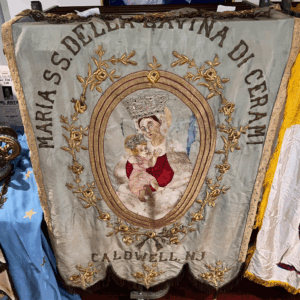
In the morning of September 7th, a procession forms at the chapel outside of the town near where the icon was miraculously discovered to take the new painting located there to visit the original icon, which now resides at the Benedictine monastery within the town.2 There are young women wearing red tunics with yellow sashes, harkening back to the time the island was Greek, and young men wearing blue shirts and black pants. Many of the faithful walk barefoot in the procession, while a band plays accompanying marches. Shouts of “Evviva! / Hooray!” and “Viva ’a Madinnuzza d’ ’a Lavina / Long-live the Little Madonna of the Torrent!” can be heard (n.b. the use of “little” in the translation should be understood as expressing the affectionate diminutive suffix present in the Sicilian). There were also, historically, penitents who wore rough clothing, called drappu, made of coarse fabric. During the procession, these penitents would cry, “ ’A Madinnuzza, ’a Madinnuzza! / The Little Madonna, the Little Madonna!” This penitential practice was expressed by the phrase jiri cu ’i carni nn’ ’a lana (to go with the body covered in wool).
Leading the procession are those called launiati, who would each carry ’na ranni bannera di lauru, a huge laurel “banner.” A bannera di lauru, which rests on the head and shoulders, is some two to three times the height of its carrier. Choice fruits of the season, sheep, hares, rabbits, foxes, tortoises, handkerchiefs with an image of the Madonna, and other such things were traditionally hung from the laurel, but nowadays only images of the Madonna. Some of the faithful make vows/promises to carry a bannera di lauru in the yearly procession if the Blessed Virgin obtain, by her intercession, the intention of the one making the vow, while some others may carry one simply out of devotion or as a motivation for the Virgin to grant their petitions. The making of such a vow is expressed by the phrase prumettiri ’u lauru (to make a vow with the offering of the laurel banner). The entrance of these laurel banners into Cerami is called the entrata d’ addauru, “the entrance of fragrance,” no doubt due to the pleasant and distinctive smell of the laurel. Laurel itself is an important and widespread plant in Sicily and is commonly used in religious celebrations throughout the island. In addition to the Madonna della Lavina celebration, the Ceramesi also use laurel during the “celebrations in honour of St. Anthony Abbot, St. Sebastian and St. Blaise.”3

Following the launiati in the procession are groups of women and then the new painting, historically adorned with rings, earrings, necklaces, and other small, precious items. At present, in such devotions, it is more common to give paper currency in place of precious jewelry and the like. The painting is carried using a device called a bajalardu. As was said above, the procession makes it way to the Benedictine monastery inside Cerami and visits the icon. A few hours after arriving, there is a second procession to return the painting to the chapel outside of the town, but this time led by the clergy and the various confraternities of Cerami. In the evening, there is a celebration with all sorts of foods and games.
While this year’s procession in Caldwell did not have anyone carrying a bannera di lauru, cuttings of laurels were provided for the faithful to carry. Also provided were feast neckerchiefs which are common at such celebrations in Sicily. They seem to be the Catholic response to political neckerchiefs. The della Lavina neckerchiefs were made in Sicily and, while they feel like silk, are 100% polyester. The design was inspired, in the first place, by the festive attire mentioned above. The women’s version is red with a yellow stripe and the men’s is blue with a black stripe. The design of the image and text imitate the design found on the old society banner. These neckerchiefs can also be seen as being reminiscent of the handkerchiefs hung from the laurel. During the procession, the image was escorted by a Knights of Columbus honor guard and a seven-piece feast band.
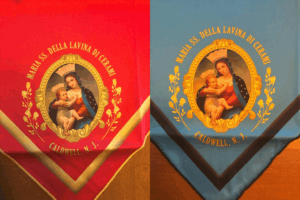
The reception which followed had some notable additions this year as well. The first being cavatieddi atturrati di Cerami. These cookies, exclusive to Cerami and one of its identity dishes, are the comune’s typical dessert. The origin of their ancient recipe is lost to history, but it reflects the humble and agricultural roots of the community. Atturratu denotes a mixture of roasted and ground almonds, sugar, and cinnamon by which the cookies are coated after being baked and dipped in sugar water. A short video on these cookies, prepared for the Milano Expo 2015, can be found here. Next there were the pears and figs. When I was young, the yearly Maria SS. della Lavina procession would stop at my grandparents’ house in Caldwell. A pear tree grew behind their house, and the fruit would ripen around that time of year. Because of this, I formed an association between the yearly feast and pears. Some of those in the procession would even pick and eat them. As it turns out, pears, specifically prickly pears (fichidindia), are consumed during the Madonna della Lavina celebration in Cerami. “Frischi e gruossi! / Fresh and large!” is the cry of the pear vendors during the feast. The selling of figs, accompanied by the shouting of “Beddi ficu, picciuotti! / Beautiful figs, boys!,” also takes place.
Next year’s celebration is scheduled for Saturday, September 19th, 2026, with Mass starting at 11 am, again at St. Aloysius church in Caldwell, New Jersey. All are graciously invited to attend.
To conclude, I present to you, dear reader, the following photographs of the 2025 event.

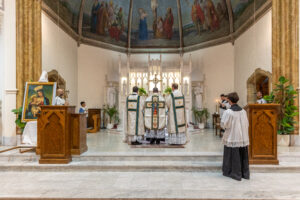

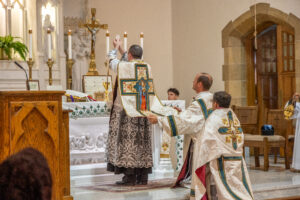
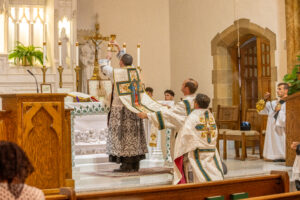

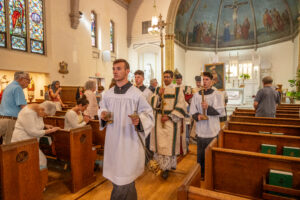



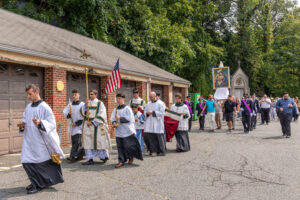
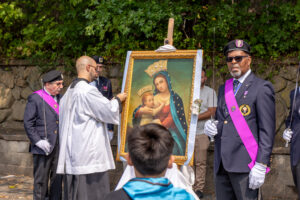
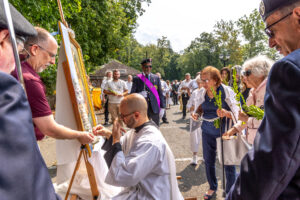
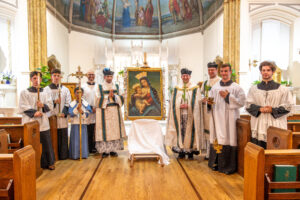
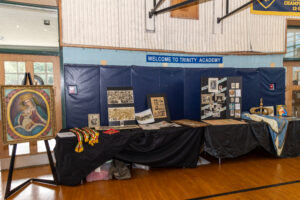

Sub tuum praesidium confugimus, Mater Lavinæ!
Rev. Cav. William Rock, FSSP, SMOCSG was ordained in the fall of 2019 and was invested as an Ecclesiastical Knight of the Sacred Military Constantinian Order of St. George in the summer of 2025. He currently resides at the FSSP Canonical House of St. Casimir in Nashua, NH, and ministers at St. Stanislaus parish.
In support of the causes of Blessed Maria Cristina, Queen, and Servant of God Francesco II, King
- The old Catholic Encyclopedia, s.v. “The Blessed Virgin Mary.”
- The majority of the information which follows about the feast in Cerami comes from Pitrè, Giuseppe. Feste Patronali in Sicilia (vol. 1). (Torino-Palermo: Carlo Clausen, 1900), pp. xli, 241-244.
- Buttitta, Ignazio E. Plants in Sicilian holy simbology. (Bocconea 28: 41-46: 22 November 2019), p. 45.
September 19, 2025

Scapular of Our Lady of Ransom
by Rev. Cav. William Rock, FSSP, SMOCSG
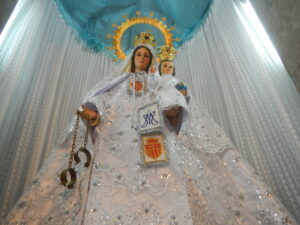
September 24th is the feast day of Our Lady of Ransom (Our Lady of Mercy), the titular feast of the Royal, Celestial and Military Order of Our Lady of Mercy and the Redemption of the Captives, more commonly known as the Mercedarians or the Order of Mercy. Originally instituted for the redemption of Christian slaves held by Muslims, “Today, friars of the Order of Mercy continue to rescue others from modern types of captivity,” such as addictions.1
Like other Orders, the Mercedarians have a scapular which can be worn by the faithful in order to associate themselves with the work and spiritual prerogatives of the Order. A ceremony for the blessing and imposition of this white scapular, which can be done by any priest,2 can be found in the traditional Roman Ritual:
The one who is to receive the scapular is kneeling. The priest, vested in surplice and white stole, says:
℣. Our help is in the Name of the Lord.
℟. Who made heaven and earth.℣. Lord, show us Your mercy.
℟. And grant us Your salvation.℣. The Lord be with you.
℟. And with your spirit.Let us pray.
O Lord Jesus Christ, Who condescended to clothe Yourself in our mortal nature, we beg You in Your boundless goodness to bless ✠ this garment, which our holy fathers have sanctioned to be worn in token of innocence and holiness. May he (she), who is to wear it, deserve likewise to put on You, Who live and reign forever and ever.
℟. Amen.The priest sprinkles the habit with holy water, and invests the person with it, saying:
By the power of our Lord Jesus Christ and that of the Apostles Peter and Paul, which has been granted to me, I present you with the habit of the Order of Our Lady of Ransom. This is done in recognition of your devotion to the most holy and immaculate Mary, Mother of God, as well as to the Order founded in her name. And having been so enrolled, may it be your good fortune to have the grace of the Holy Ghost in this life, and everlasting glory, the reward of the elect, in the life to come; in the name of the Father, and of the Son, ✠ and of the Holy Ghost.
℟. Amen.Then the “Veni Creator” is said, followed by:
℣. Send forth Your Spirit and all things shall be recreated.
℟. And You shall renew the face of the earth.℣. Save Your servant.
℟. Who trusts in You, my God.℣. The Lord be with you.
℟. And with your spirit.Let us pray.
O Lord, hear our humble prayers, and be pleased to bless ✠ this servant of Yours whom we clothe in your Holy Name with the habit of the Order of Our Lady of Ransom. He (she) deserves out of piety to wear it as long as he (she) lives, so that by Your bountiful help he (she) may remain loyal to Your Church, and finally attain everlasting life through Christ our Lord.
℣. Amen.3
No doubt there are many Catholics today who are involved in work which would align with that of the Order of Mercy, striving to rescue their fellowmen from captivity, be it due to exploitation, trafficking, addictions, or other similar conditions. It seems to me that it would be fitting for such Catholics to associate themselves more closely with Our Lady of Ransom and the Mercedarians by being clothed in this Scapular. Similarly, those who find themselves subject to one of these modern-day captivities would do well to place themselves under the mantle of Our Lady of Ransom.
Rev. Cav. William Rock, FSSP, SMOCSG was ordained in the fall of 2019 and invested as an Ecclesiastical Knight of the Sacred Military Constantinian Order of St. George in the summer of 2025. He is currently assigned to St. Stanislaus Parish in Nashua, NH.
In support of the causes of Blessed Maria Cristina, Queen, and Servant of God Francesco II, King
- About | Mercedarian Friars USA
- The Old Catholic Encyclopedia, s.v. “Scapular.”
- Rituale Romanum [1957], Titulus IX – Caput 11, 21; English adapted from the Weller translation provided online by EWTN (2, XV, 21)
September 1, 2025

Votive and Devotional Habits
by Rev. Cav. William Rock, FSSP, SMOCSG
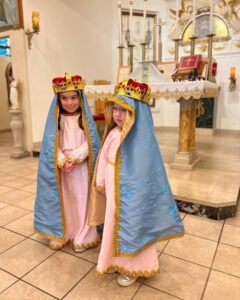
In Southern Italy and in the Italian diaspora, there is a tradition of wearing habits based on the usual appearance of a saint (abitini; abitinu in Sicilian; habitus or vestes in Latin). In many cases, the habit chosen is that of a local patron(ess), but it could also simply be that of a saint chosen out of personal or familial devotion. There is also variety as to the when and the why a habit is worn. In some cases, one might vest as a saint on his or her feast day solely out of devotion. In other cases, the vestiture is worn as the fulfillment of a vow (votive or ex voto). It is common in Southern Italy to “bargain” with the saints. In this case, the bargainer vows the wearing of the habit of the saint if the saint obtains, by his or her intercession, the intention of the bargainer. It could be that the bargainer himself vows to wear the habit, which is commonly done yearly on the saint’s feast day, but it could also be the case that it is to be worn daily, or it could be that the bargainer vows that another will wear it. An example of the latter is that parents would promise that a mortally sick child, if he recover through the intercession of the saint, would wear the saint’s habit daily until his first Holy Communion. The child himself may decide to continue wearing the habit afterwards, either daily or on the feast day, out of devotion and as a continued thanksgiving. By way of illustration, with regards to the promise to personally wear it, a mother may vow to wear the habit yearly on the appropriate feast day (or even every day for the rest of her life) if her son, through the intercession of the saint, return safe from war. There are even cases where the vow is continued by descendants after the death or incapacity of the one originally obligated out of gratitude towards the saint.1
Lest those who practice what has been thus far described be accused of impiety or something bordering on superstition or paganism, it ought to be pointed out that this “bargaining” is more properly, and technically, the making of a conditional, suspensive vow, “that is to say, [a vow which makes] the commencement of the obligation depend on the happening or the not happening of some future uncertain event; for instance, the words, ‘If I recover my health’, make the obligation commence upon the recovery.”2 In a conditional, suspensive vow, then, one would only fall under the obligation of the vow (such as the wearing of a habit ex voto) if the condition placed on the vow is fulfilled by the other party invoked, be that party either God Himself or one of the saints. Regarding specifically vows to the saints, “God is well pleased with the honour paid to His saints, and they rejoice at the glory given to God. We may then confirm by a vow the promise made to a saint, and likewise we may honour a saint by a vow made to God, as for instance, to erect in memory of some saint a temple for Divine worship”3 or, as in the case under consideration here, to wear a votive habit.

The making of such conditional, suspensive vows have a foundation in Sacred Scripture where, for instance, Anna “made a vow, saying: O Lord of hosts, if thou wilt look down, and wilt be mindful of me, and not forget thy handmaid, and wilt give to thy servant a manchild: I will give him to the Lord all the days of his life, and no razor shall come upon his head” (1 King [Samuel] 1:11). Anna here is making a conditional, suspensive vow. If God will remove her barrenness, then she will dedicate the first male child she may have to the service of the Tabernacle. God granted her request, and she gave birth to the Prophet Samuel (1:20). Once Samuel was weaned, but still “very young” (1:24), the child, in fulfilment of the vow made by his mother, was offered to the High Priest and lived and served with him at the Tabernacle (2:11). Samuel, even though he was a child, was vested as a priest, wearing a vestment made for him by his mother (2:19-20; Samuel himself was of the Tribe of Levi according to the genealogies in the First Book of Chronicles). In all this, not only is there an example of a conditional, suspensive vow, but one in which the obligation is shared both by the one making the vow and her child, just as can be the case in the wearing of a habit ex voto.
While the wearing of habits ex voto or out of devotion is a great example of folk religious practice (and an expression of how thin the veil is between the here and the hereafter, how close and real the saints are in the spirituality of Southern Italians), it is not without liturgical support. An edition of the Franciscan Ritual contains a quite elaborate ceremony for the clothing of boys or girls in votive habits (Ritus induendi pueros vel puellas habitu ex voto) and an edition of the Dominican Ritual has an equally complex ceremony for vesting children in the Dominican habit, either out of devotion or in the fulfillment of a vow (Ritus induendi puerum, vel puellam, ex devotione, vel voto habitu Ordinis Nostri). The traditional Roman Ritual, for its part, contains two comparatively simple blessings. The first is the blessing of a habit (vestis) in honor of the Blessed Virgin Mary:
℣. Our help is in the Name of the Lord.
℟. Who made heaven and earth.℣. The Lord be with you.
℟. And with your spirit.Let us pray.
O Lord, bless ✠ this habit which is to be worn in honor of the blessed Virgin Mary, and under her patronage; and grant that he (she) who is to wear it may obtain health in body and protection in soul; through Christ our Lord.℟. Amen.
The habit is sprinkled with holy water.4
The second blessing is for a habit to be worn in honor of the blessed Virgin Mary or of any canonized saint:
℣. Our help is in the Name of the Lord.
℟. Who made heaven and earth.℣. The Lord be with you.
℟. And with your spirit.Let us pray.
O Lord Jesus Christ, Who in becoming man for our salvation deigned to assume our vesture of flesh, bless ✠ this habit with a holy benediction, for Your servant is to wear it in thanksgiving to You, with all devotion and a holy intention, and in veneration of the blessed Virgin Mary (or of St. N.). Pour out on him (her), we pray, Your holy blessing, ✠ so that when he (she) first puts on this garb, which is like that of a religious, he (she) may obtain, through the prayers of the blessed Virgin Mary (or of St. N.), Your grace to protect him (her) from every evil of mind or body. We ask this of You who live and reign forever and ever.℟. Amen.
The habit is sprinkled with holy water.5

As I am winding things up, I would be remiss if I did not strongly advise that the making of a vow or religious promise should generally only be done after receiving permission from a priest, preferably one’s pastor or regular confessor/spiritual advisor. Besides, when the practice under discussion in this article is done today, it is generally done devotionally not promissorily. Now, that being said, while it would be wonderful to see the wearing of votive habits become more common, after all there is a basis for it in the Ritual, I understand that the wearing of a votive habit will not resonate with everyone. But, if the wearing of a votive habit is something that you or yours, dear reader, are interested in, please discuss it with your pastor or regular confessor/spiritual advisor.
Rev. Cav. William Rock, FSSP, SMOCSG was ordained in the fall of 2019 and invested as an Ecclesiastical Knight of the Sacred Military Constantinian Order of St. George in the summer of 2025. He is currently assigned to St. Stanislaus Parish in Nashua, NH.
In support of the causes of Blessed Maria Cristina, Queen, and Servant of God Francesco II, King
- The information for this paragraph was supplied by Mr. Patrick A. O’Boyle, Esq., SMOCSG and Mr. Brendan Young, SMOCSG. Thanks are owed to them for this. It is also worth noting that there were/are other such ex voto practices. Here, however, ex voto is more expansive in meaning than that used in the main article and could mean anything given or done either to obtain the favor of God or a saint, or in thanksgiving for a favor received, with or without an accompanying vow or promise, or something given or done simply out of devotion. For example, some walk barefoot in the saint’s feast day procession while others carry customary votives on their heads, which could range from piles of candles (e.g. the cinte/Italian candle-houses associated with the Madonna del Sacro Monte near Novi Velia, Salerno) to banners of laurel branches upon which hang products of the season (rabbits, hares, seasonal fruit) along with colored handkerchiefs (the bannera di lauru of Cerami, Sicily for the Madonna della Lavina). If someone were healed, wax, or even metal (sterling silver), shaped into the healed body part could be offered. Metal ex votos in various sizes and designs (e.g., houses, newborn babies) are also common as well as ex voto paintings. It was also customary in Southern Italy, and afterwards in the diaspora, to offer jewelry (e.g., wedding rings, earrings, watches, necklaces, strings of peals, military medals, etc.) to adorn images of saints (attached by metal loops and the like) or (less common) frames carried in a saint’s procession. When not in use, the jewelry would be kept in a safe place until needed. After its introduction in the 1870s, paper currency was used in this manner as well. Additional information can be found in the old Catholic Enyclopedia article “Votive Offerings” and in the first chapter of Robert A. Orsi’s The Madonna of 115th Street.
- Old Catholic Encyclopedia, s. v. Vows.
- Ibid.
- Rituale Romanum [1957], Titulus IX – Caput 8, 13; English adapted from the Weller translation provided online by EWTN (2, VII, 20).
- Rituale Romanum [1957], Titulus IX – Caput 8, 14; English adapted from the Weller translation provided online by EWTN (2, VII, 21).
August 4, 2025

Mass, Novena & Procession for the Return of Lost Sheep
“I Love Jesus Christ and that is why I am on fire with the desire to give Him souls, first of all my own, and then an incalculable number of others.”
—Saint Alphonsus Liguori
The National Shrine of Saint Alphonsus Liguori in Baltimore is preparing to celebrate its patronal feast day on August 2nd! And again this year, we are offering a novena of Masses and a Procession for the return of lost sheep. Saint Alphonsus was given by God a particular zeal and a special grace for the conversion of souls. As the patron saint of arthritis and the ailments afflicting the connective tissues in the body, we see also his gift as Doctor of the Church to aid the afflictions of the Mystical Body.
In honor of our blessed patron, Saint Alphonsus, and as we prepare for our Novena of Masses begging our Lord for the graces necessary for all those lost sheep who are not in the fold of the Catholic Church or who have grown cold in their love for God, we offer this meditation by Saint Alphonsus. It is taken from his Way of Salvation and is entitled, “On the joy of Jesus Christ at finding the lost sheep.”
“Our blessed Savior says of himself, in Saint Luke (c. 15), that He is the affectionate shepherd, who, having lost one of His hundred sheep, leaves the ninety-nine in the desert, and goes in search of the one that is lost; and finding it, receives it with joy, takes it on His shoulders, and returning home calls together his neighbors to rejoice with Him, saying, Rejoice with me, because I have found My sheep that was lost. O divine shepherd! I have been that lost sheep, but Thou hast sought me until, as I hope, Thou hast found me. Thou hast found me and I have found Thee. How shall I ever again stray away from Thee, my beloved Lord? And yet such a misfortune may happen to me. Oh, permit it not; never suffer me, O Jesus! to leave Thee and to lose Thee again.
“But why, O Jesus! dost Thou call together Thy friends to rejoice with Thee for having found the lost sheep? Shouldst Thou not rather bid them rejoice with the lost sheep for having again found Thee, its God? But so great is Thy love for my poor soul that Thou esteemest it Thy happiness to have found it! My dearest Redeemer, since Thou hast found me, bind me to Thee with the blessed bonds of Thy holy love, that I may always love Thee and may nevermore depart from Thee.
“God, says the prophet, no sooner hears the voice of the penitent sinner crying to Him for mercy, than He immediately answers and forgives Him. At the voice of thy cry, as soon as He shall hear, He will answer thee. Behold me then at Thy sacred feet, O God! grieved from the bottom of my heart for having so often offended Thee, and craving Thy compassion and pardon. I can no longer endure to behold myself at a distance from Thee and deprived of Thy love. Thou art infinite goodness, and most worthy of infinite love. If hitherto I have despised Thy grace, I now value it above all the kingdoms of the earth. And because I have offended Thee, I beseech Thee to avenge thyself upon me, not indeed by casting me away from Thy face, but by giving me such a sorrow for my sins as may cause me to lament my guilt before Thee, all the days of my life. Lord, I love Thee with my whole heart, and as I cannot trust that I shall continue faithful to Thy love, be Thou my help and my succour. And do thou, O holy Virgin! help me with thy holy intercession.”
With confidence we can call on Saint Alphonsus’s powerful intercession for nothing less than the complete and total conversion of our own souls, as he was wont to beg us to accomplish, and for the conversion of others, too. You are invited to visit the Shrine’s website to enroll your intentions in the Mass Novena that begins Saturday, August 2nd.
You are also invited to join us live online for a preached novena leading up to our parish feast day. Beginning with Mass on Thursday, 24 July, daily broadcasts of Mass and its sermon are available on our YouTube channel. See the Shrine’s website for more details, links, and the schedule:
https://stalphonsusbalt.org/return
July 29, 2025

Blessing of Processional Banners
by Fr. William Rock, FSSP
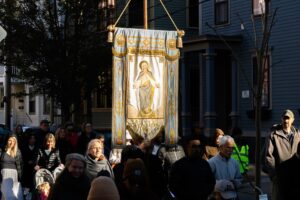
In the beginning of April 2025, I was contacted concerning how to properly decline a Latin title of Our Lady for use in the blessing of a processional banner. I had never heard of this blessing before and, after providing feedback about the Latin, asked where the blessing is found. It turns out that the blessing is contained in the standard Roman Ritual. On the following Holy Thursday, as the parish was preparing for the evening’s liturgy, I was asked if the organizational banners which would be used in the Eucharistic procession should be blessed/if I was willing to bless them. I jumped at the chance to use the blessing about which I had recently learned. The hand of Providence, perhaps, can be seen in all of this.
The following is a translation of the blessing of a processional banner for any congregation:
℣. Our help is in the Name of the Lord.
℟. Who made heaven and earth.℣. The Lord be with you.
℟. And with your spirit.Let us pray.
Lord Jesus Christ, Whose Church is like a well ordered battle-array, bless ✠ this banner; and grant that all who fight under this standard for Your sake, O Lord God, may by the prayers of Blessed N. overcome their visible and invisible enemies in this life, and after this victory come as conquerors to the kingdom of heaven. We ask this through You, Jesus Christ, Who live and reign with God the Father and the Holy Ghost forever and ever.℟. Amen.
The banner is sprinkled with holy water.1
It was very common in the past for different congregations (be they societies, confraternities, sodalities, guilds, religious associations, Tertiaries, and the like) to have their own processional banners upon which was emblazoned the image of their respective heavenly patron or patroness. It would be this patron or patroness who would be named while the blessing was being imparted. Even today, these banners can lead members of their respective congregations during the various processions of the year, such as on the Purification, Palm Sunday, Holy Thursday, the Rogation Days, Corpus Christi, and any local processions. In these processions, the banners and members, in their dress and insignia, precede the processional cross,2 though the laity usually follow behind the sacred ministers. When not in use, the banners may be displayed near a shrine or side altar in the local church dedicated to their patron or patroness, if one be present.
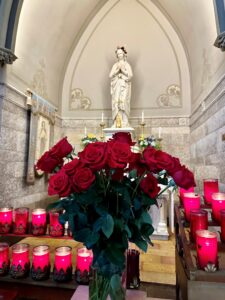
Both in the title and the text, the Latin for banner is “vexillum,” the same word applied to the Cross in the famous processional hymn of Venantius Fortunatus, Bishop of Poitiers, [† c. A.D. 600], the Vexilla regis prodeunt, sung during Passiontide, and also in the Secrets of the Masses of the Finding (3 May) and Exaltation (14 September) of the True Cross and in the Collect of the Votive Mass of the Holy Cross (outside of Paschaltide). While the word can be translated simply as “banner,” it should be understood that “the vexillum was the old Roman cavalry standard, which, after Constantine, was surmounted by a Cross instead of by the Roman eagle.”3 The specific use of this word, and its application to a processional banner, explains the militaristic tone of the blessing which begins by implying that the Church here below is a Church Militant.
The members of the congregation, as the blessing explains, are expected to fight against their visible and invisible enemies, that is, against the false maxims of this fallen world, against the sinful concupiscence of the flesh, and against the snares and traps of the devil and his fallen angels, using the weapons of prayer, fasting, and almsdeeds. By so doing, aided by the intercession of their heavenly patron(ess), it is hoped that they will receive an eternal reward as victors and conquerors.
In conclusion, dear reader, if your parish has congregational banners, it might be worthwhile for the leads of the different organizations to arrange to have them blessed if they are not so already and to promote their use, and the attendance of the members, at the various processions of the year. If your parish congregations do not have such banners, perhaps this article will serve as the impetus for their procuring of them.
Fr. William Rock, FSSP was ordained in the fall of 2019 and is currently assigned to St. Stanislaus Parish in Nashua, NH.
In support of the causes of Blessed Maria Cristina, Queen, and Servant of God Francesco II, King
- Rituale Romanum [1957], Titulus IX – Caput 8, 3; English adapted from the Weller translation provided online by EWTN (2, VII, 24).
- Britt, Matthew. The Hymns of The Breviary and Missal. (New York: Benziger Brothers, 1936), p. 124.
- Fortescue, A., O’Connell, J.B., & Reid, A. The Ceremonies of the Roman Rite Described (15th ed.). (New York: Burn & Oates, 2009), p. 390, n. 42.
July 7, 2025

The Missions of the Holy Ghost
by Fr. William Rock, FSSP

On the Feast of Pentecost, the Church celebrates the descent of the Holy Ghost on the Apostles and Disciples following the Lord’s Ascension. While this is an extremely important moment in the Church’s history, it ought to be noted that this is not the first visible mission of the Holy Ghost, but the fourth.
To begin with, a visible mission (Latin: missio, “sending”) of a Divine Person is a sensible manifestation which expresses the supremely important spiritual realities being brought about outside of the Divinity by a Divine Person Who was sent by another Divine Person (or Persons) in a manner which is able to be known by man, whose knowledge begins with his senses. With respect to the Holy Ghost, these missions were “directed to Christ, to the apostles, and to some of the early saints on whom the Church was in a way founded” (S.T. I, q. 43, a. 7, ad 6).
In the first place there was the visible mission of the Holy Ghost in the form of a dove at the Lord’s baptism (Matt 3:13-17; Mark 1:9-11; Luke 3:21-22). As St. Thomas explains in his theological Summa: the form of a dove, “a fruitful animal…show[s] forth in Christ the authority of the giver of grace by spiritual regeneration; hence the Father’s voice spoke, This is My beloved Son (Matt 3:17), that others might be regenerated to the likeness of the only Begotten.”
The second visible mission of the Holy Ghost was in the form of the bright cloud at the Lord’s transfiguration (Matt 17:1-13; Mark 9:1-7; Luke 9:28-36). According to St. Thomas, this manifestation in the form of a bright cloud represented “the exuberance of doctrine; and hence it was said, Hear ye Him (Matt 17:5).”
On the evening of the Resurrection, the Risen Lord breathed on the Apostles and said to them “Receive ye the Holy Ghost” (John 20:22). This is the third visible mission. The fourth visible mission, as was mentioned, occurred at Pentecost and was manifested by the sound of a mighty wind and by tongues of fire (Acts 2:2-3). St. Thomas explains these missions as follows: “To the apostles the mission was directed in the form of breathing to show forth the power of their ministry in the dispensation of the sacraments; and hence it was said, Whose sins you shall forgive, they are forgiven (John 20:23): and again under the sign of fiery tongues to show forth the office of teaching; whence it is said that, they began to speak with diverse tongues (Acts 2:4).”

It should be noted that the visible mission of the Holy Ghost at Pentecost is unique in that it is the only time the Holy Ghost had a visible mission without a manifestation of either of the other two Divine Persons. At the Baptism and Transfiguration, all three Divine Persons were manifested. On the day of the Resurrection, the Son was also manifested. The visible manifestation of the Holy Ghost alone at Pentecost indicates the beginning of a new era, the era of the Church, which the Holy Ghost guides as history unfolds.
In the last two visible missions, the Holy Ghost manifests that what had been indicated previously with regards to the Son has been entrusted to the Apostles. There is a connection between Christ’s Baptism and the Breathing of the Holy Ghost in that the former shows Christ as the “giver of grace” and the pattern of the regenerated Faithful, while the latter shows the entrusting to the Apostles of the Sacraments which are the primary means by which Christ gives grace and conforms the Faithful to Himself. There is also a connection between the Transfiguration and Pentecost in that the former expresses that Christ is teaching a divine doctrine, and the latter expresses that the Apostles were entrusted with a teaching office to preach the same doctrine. These connections show that the Apostles, and, by extension, their successors, were empowered by the Holy Ghost to continue the work of Christ, teaching and sanctifying in the world with divine power. But this also means that the second two visible missions of the Holy Ghost cannot be fully understood without referencing the first two.
Fr. William Rock, FSSP was ordained in the fall of 2019 and is currently assigned to St. Stanislaus Parish in Nashua, NH.
In support of the causes of Blessed Maria Cristina, Queen, and Servant of God Francesco II, King
June 8, 2025

